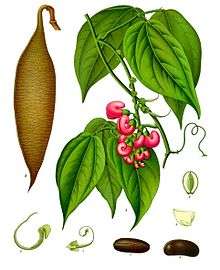Physostigma venenosum
| Calabar bean | |
|---|---|
 | |
| Scientific classification | |
| Kingdom: | Plantae |
| (unranked): | Angiosperms |
| (unranked): | Eudicots |
| (unranked): | Rosids |
| Order: | Fabales |
| Family: | Fabaceae |
| Subfamily: | Faboideae |
| Genus: | Physostigma |
| Species: | P. venenosum |
| Binomial name | |
| Physostigma venenosum Balf. | |
Physostigma venenosum (the Calabar bean or ordeal bean) is the seed of a leguminous plant, a native of tropical Africa, poisonous to humans. It derives the first part of its scientific name from a curious beak-like appendage at the end of the stigma, in the centre of the flower; this appendage, though solid, was supposed to be hollow (hence the name from φῦσα, a bladder, and stigma).
Growth
The plant is a large, herbaceous, climbing perennial, with the stem woody at the base, up to 2 inches (5 cm) in diameter; it has a habit like the scarlet runner, and attains a height of about 50 feet (15 m). The flowers, resting on axillary peduncles, are large, about an inch long, grouped in pendulous, fascicled racemes pale-pink or purplish, and heavily veined. The seed pods, which contain two or three seeds or beans, are 6 or 7 inches (15 or 18 cm) in length; and the beans are about the size of an ordinary horse bean but much thicker, with a deep chocolate-brown color.
Toxicology
Calabar bean contains physostigmine, a reversible cholinesterase inhibitor alkaloid. The alkaloid physostigmine acts in effect like nerve gas,[1] influencing communication between the nerves and muscles, and resulting in copious salivation, seizures, loss of control over the bladder and bowels, and eventually loss of control over the respiratory system, causing death by asphyxiation.
The main antidote to Calabar bean poisoning is atropine, which may often succeed; and the other measures are those usually employed to stimulate the circulation and respiration. Unfortunately, the antagonism between physostigmine and atropine is not perfect, and Sir Thomas Richard Fraser has shown that in such cases there comes a time when, if the action of the two drugs is summated, death results sooner than from either alone. Thus atropine will save life if three and a half times the fatal dose of physostigmine has been taken, but will hasten the end if four or more times the fatal dose has been ingested.[2][3]
Historical uses
They constitute the E-ser-e or ordeal beans of the people of Old Calabar, being administered to persons accused of witchcraft or other crimes. In cases where the poisonous material did its deadly work, it was held at once to indicate and rightly to punish guilt; but when it was rejected by the stomach of the accused, innocence was held to be satisfactorily established. A form of dueling with the seeds is also known among the natives, in which the two opponents divide a bean, each eating one half; that quantity has been known to kill both adversaries. Although thus highly poisonous, the bean has nothing in external aspect, taste or smell to distinguish it from any harmless leguminous seed, and disastrous effects have resulted from its being incautiously left in the way of children. The beans were first introduced into Britain in the year 1840; but the plant was not accurately described until 1861, and its physiological effects were investigated in 1863 by Sir Thomas Richard Fraser. The bean usually contains a little more than 1% of alkaloids. Two of these have been identified, one called calabarine with atropine-like effects, and the other, the drug physostigmine, used in the treatment of anticholinergic syndrome, myasthenia gravis, glaucoma and delayed gastric emptying.
References
- ↑ Colovic, MB; Krstic, Danijela Z.; Lazarevic-Pasti, Tamara D.; Bondzic, Aleksandra M.; Vasic, Vesna M. (2013). "Acetylcholinesterase Inhibitors: Pharmacology and Toxicology". Current Neuropharmacology. 11 (3): 315–335. doi:10.2174/1570159X11311030006.
- ↑ Fraser, T. R. (1867). "On the Physiological Action of the Calabar-bean (Physostigma venenosum Balf.)". Transactions of the Royal Society of Edinburgh. XXIV.
- ↑ Fraser, T. R. (1867). "On the Physiological Action of the Calabar Bean". Journal of Anatomy and Physiology. 1 (2): 323–332. PMC 1318559
 . PMID 17230725.
. PMID 17230725.
 This article incorporates text from a publication now in the public domain: Chisholm, Hugh, ed. (1911). "Calabar Bean". Encyclopædia Britannica (11th ed.). Cambridge University Press.
This article incorporates text from a publication now in the public domain: Chisholm, Hugh, ed. (1911). "Calabar Bean". Encyclopædia Britannica (11th ed.). Cambridge University Press.- "The killer bean of Calabar", Laura Spinney, Histories, New Scientist, 28 June 2003.
- "A Modern Herbal", Maude Grieve (1931)